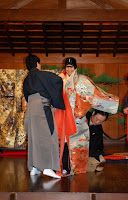On Thursday we met at Temmangu Shrine, commemorating Lord Michizane Sugahara, an ancient patriot. Shinto shrines can commemorate events, honor (enshrine) individuals, or pay respect to natural forces. It is not uncommon for the Japanese to practice both Shinto and Buddhism. As Ohno-san, one of our GSE advisors explained to me today, "Usually we have Shinto rites for birth, sometimes a Christian wedding, and Buddhist ceremonies at death."
Temmangu was built 1070 years ago, and is famous for the Tenjin Festival, one of the three largest annual festivals in Japan. The symbol of the shrine is the plum, seen in an icon on the glass in the adjacent photo. Plum carvings also decorate the rafters, and we received a gift of plum sake from Terai-san, the head priest (#3 priest in all of Japan).
We participated in an offering ceremony, then got to listen to the temple priests play gagaku. Gagaku (literally "elegant music") is Japanese classical music which was introduced from China around the 6th century, and consists of wind, string and percussion instruments. Makoto later told me that we know more about Japanese culture than he does now-- most Japanese never get to enter the temple interior where we were, or hear gagaku.
In the afternoon we visited the Sakai power plant of Kansai Electric Power Company.
Our hosts were very excited to see us, and gave us the best tour they could give. I left my camera on the bus though, so just got a few phone pics...
That night I joined Ohmichi-san and a few of his friends at an izakaya where we had "salt rock" beef and fish-- a flat salt rock was heated at the table, and we cooked the food on the spot. It was delicious, but I ate way too much and made the mistake of telling them "Nandemo ii desu" ("Anything is good") when they asked me what I could drink.
After way too much beer, cold sake, warm sake and whiskey, we went next door to a karaoke bar. I acquitted myself on the mike, but this is what the world looked like as I sang "Fly Me to the Moon"...
Needless to say, I was not feeling too well the next day. We had a nice visit to a Noh theater in the morning though. The theater is owned by Akihiro Yamamoto, and has been in the family for 80 years. Noh is a classical Japanese musical drama that has been performed for over 600 years. It is highly stylized, with costumes and masks playing a large part in telling the story. Male actors play both male and female roles.
Most of the masks are very subtly different-- the two in this photo depict a young girl on the right, and a woman in her 20s on the left. Michelle got to play dress-up and put on the whole ensemble, which took about ten minutes. Yamamoto-san invited us to a play on Saturday night, but we were scheduled to have a "free" weekend outside of town so we had to decline.
After a lunch meeting, the group split up-- Bryan, Kasey and Chris went on the scheduled boat cruise while Michelle, Kathleen and I opted for some rare free time. We were left at Osaka Station, which is literally the first time we have been left alone in public. After some brief confusion, we found our way to a coffee shop to relax...
The next day was my last day with the Ohmichi family. Ohmichi-san and I walked around the neighborhood for a while, and I suddenly realized we were less than a block from the Hamatani residence.
We walked down the street and saw Emiko-san out front-- she was surprised to see me, but it was great to chat briefly. We took the chin-chin densha to Sumiyoshi Shrine, then headed home to pick up Sachi-san and Makoto for lunch.
After a delicious bowl of tempura udon, the Ohmichis dropped me off at the hotel. From there it was onward to Okuda-san's house in Nishinomiya, Texas bar night with the Stampede band, and a bit of relaxation...
Haiku # 13
lotus flower floats
in a bowl of steaming broth
colored red with shrimp





























































